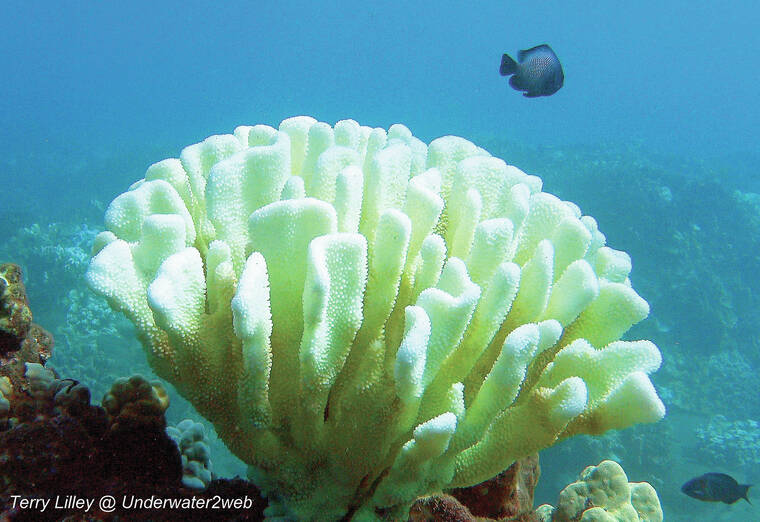There have been a lot of articles lately in the news about coral bleaching and how rising sea temperatures may be to blame. It is easy to attach a cause to the decline of our coral reefs on earth, but the sea is very complex and what kills corals in Australia or Indonesia may not be killing corals in Hawai‘i.
Every coral reef is different and analysing why corals may be dying needs to be specific for each reef system. Many coral reefs grow in very dry shallow lagoons worldwide, but Hawaiian corals grow on steep underwater cliffs that are exposed to the open ocean and our coral growth is unique to Hawai‘i.
In 2015, Hawai‘i had an abnormal amount of hurricanes pass by the island chain, and we had a lot of rain in areas that normally do not see much annual rainfall. The Westside of Maui and Kona Coast of Hawai‘i Island are usually very dry, but in 2015 the normally brown hills were bright green due to all the rain they received from the passing hurricanes.
The shallow water coral reefs in Maui and Hawai‘i suffered a massive bleaching event that killed a lot of coral; scientists were quick to blame the bleaching on a 2 degree rise in sea temperatures.
This seemed odd to me because I have recorded a 5 degree change in sea temperature on Hawaiian coral reefs from winter to summer, and also daily changes in sea temperature just due to a tide change and wave activity. So why would the corals bleach so quickly with a 2 degree sea temperature change?
During this 2015 bleaching event, I traveled to seven of the Hawaiian Islands to do a coral bleaching study. I found very little coral bleaching in Lana‘i and Molokai, and moderate coral bleaching on the dry side of O‘ahu and Kaua‘i, but major coral bleaching in West Maui and Hawai‘i Kona Coast.
It became clear to me that the reefs that bleached were on the dry side of each island and not used to being flushed with fresh water from rain.
The north shores of O‘ahu and Kaua‘i had very little bleaching and the corals there are used to constant rain flowing out onto the reef. I also discovered that the corals that were in very shallow water in Maui and Hawai‘i all bleached, where as the deeper you went there was less bleaching.
Shallow water corals grow algae in their tissue that helps feed the coral polyps. This algae gives the coral its color. If the algae was to die. then the coral “bleaches” and turns pure white.
If the bleaching lasts longer than about 30 days, the coral may die. In 2015, the corals did not bleach in Lana‘i and Molokai even though the sea temperatures were the same as they were on Maui and Hawai‘i Island where the corals did bleach.
What became obvious to me is the coral bleaching was in the areas that received an abnormal amount of rain from the passing hurricanes.
I have observed corals growing well in Hawai‘i in some of the warmest waters in the entire island chain, and during the 2015 coral bleaching event the sea temperatures lowered due to the cool high mountain fresh water run off. Too much fresh water in the sea can kill the algae that grows in the coral tissue causing the coral to bleach.
Once the hurricanes had passed and the fresh water runoff stopped, the corals grew new algae in their tissue and returned to their normal colors. Most of the bleached corals survived and now are back in good shape.
We now understand that corals can bleach and die from a freshwater bleaching event and any other event that changes their environment too quickly.
Mud from a landslide or coastal development can flow out onto a coral reef and cause a bleaching event and leaking cesspools can do the same.
Warmer sea temperatures can cause pollutants in the sea water, like nitrates from fertilizers, to be more toxic than normal. Submarine activity discharging electricity into the sea water can cause the corals to bleach and die.
There are many environmental changes that can cause coral bleaching, so it is important to look at every bleaching event and try to figure out what caused it and not simply blame it all on sea temperature rise.
You can see some of the 2015 bleaching event in Maui in my movie on YouTube about Maui marine life on my YouTube channel at Underwater2web.
•••
Terry Lilley is a marine biologist living in Hanalei Kaua‘i and co-founder of Reef Guardians Hawai‘i, a nonprofit on a mission to provide education and resources to protect the coral reef. To donate to Reef Guardians Hawaii go to www.reefguardianshawaii.org.


